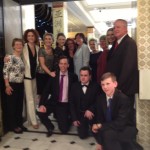The issue surfaces as something like …
“I invite clients to have lunch and I don’t hear back from them.” “I guess this means they really aren’t interested in getting together.”
Do you really think that’s true? Do your clients and prospects not want to talk to you? You do offer value added services that improve revenues or cut costs don’t you? Or do the services reduce risks, improve client satisfaction or improve productivity? Maybe they just make the client compliant in some way? Why would they not want to see you? Wouldn’t you see someone who could do that for you?
Now ask yourself this question. Do you have unanswered e-mails in your inbox? Email overload is a problem for most business people.
I know I do! People are very very busy. Their inboxes are full of e-mails that range from urgent/important to annoying /unimportant. Given that reality, returning your e-mail may just not be as high a priority for them as getting a response to that e-mail is to you. A different slant on your email etiquette can help.
Fortunately, there are a few things you can do to get more responses to your invitations.
1. Ask again. One or two non-responses do not make a rejection.
2. Make a call instead of e-mailing (and leave a really good voice mail if you don’t speak to them ).
3. Try at a different time of day. Their schedule may be less frantic on Friday afternoon than on Monday morning. After hours may be a better time than the middle of the day. Early better for them than late.
4. Make your invitation VERY specific. Please don’t write something like “Let’s have lunch soon,”. Much better to ask “Are you available for lunch on Monday, April 22 or Wednesday April 24.” Alternatively, give them a window of time for a phone call — the morning of the 19th or the afternoon of the 25th . If they’re not available on the dates you suggest, ask them specifically to counter with dates or times they are available.
5. Consider inviting them to something other than lunch. Lots of people tend to eat lunch at their desk. Suggest breakfast. How about dropping by their office for 15 minutes and bringing along their favorite Starbucks order? Maybe an early evening phone or Skype meeting? Connecting at a conference you both plan to attend?
Rob Biggin is the founder of Rainmaker Coaching, leaders in business coaching and mentoring to improve business performance. This was originally posted on his blog and we thank Rob for sharing it with us.
Tags: corporate email etiquette, email, email best practice, Rainmaker coaching, Rob Biggin
Executive Secretary Live – a two day event for top notch Executive Assistants and PAs from around the world was launched this weekend. Delegates came from the UK, Russia, Belgium, France, Australia and the USA. It was a momentous and exciting two days. There was a mix of sessions on the soft skills such as communications and networking and the hard skills of producing a procedures manual and using Microsoft Office to save time. For those who missed the event, here is my take on the highlights.
Bonnie Low-Kramen opened the conference with a session on how crucial communications skills are if you want to be the ultimate top EA/PA. She discussed how to bridge the gap between the way different generations and personalities communicate. For me the top tips were around improving your body language.
There were two jaw dropping session from Vickie Sokolov Evans on how to exploit the power of Microsoft Office. Most of us use only 13% of the functions in Office. Yet there are another 87% which are guaranteed to save you time if only you know where they are and how to use them. The ones which set me alight were how to use the Styles function.
Why is it that some days it all goes pear shaped? One reason is often lack of clear procedures. Julie Perrin ran an excellent hands-on workshop on how to produce a Procedures Manual which will not only save your day but help those who cover for you. Having such a manual will help you stand out as an outstandingly well organised PA/EA.

Speakers and Organisers
How many of us reach a certain age and point in our career when we think can I grow any more? Eth Lloyd gave a very personal account of gaining a Masters late in life and through that experience helping others to reach for the sky.
What is it about some people that they walk into a room and can persuade people to do something? It’s all down to charisma as Susie Barron Stubley showed us. You need to create presence, power and at the same time warmth and these are skills which can be learned if you work at changing your mental state from negative to positive. Neutralize negativity was her key message for me.
This was a point which Doug Dickerson underlined in his session. Attitude and expectations are what limits most of us from becoming centers of excellence. Raise your expectations and you will be amazed at what you can achieve was what I took away from Doug and Eth’s sessions.
Laura Schwartz closed the conference with an amazing session on the power of networking and how to do it properly. The key messages for me are to research who you are meeting and identify two key people you want to meet at each event and what you want to ask them. And remember it is not about what the other person can do for you, but what you can do for them.

The ‘E-Babes’ – Marsha Egan and Monica Seeley
What was I doing at this extraordinary meeting of talented speakers and delegates? I was one half of the ‘E-Babes’. I had the enormous pleasure and honour of running an email best practice workshop with Marsha Egan of Inbox-Detox. Lucy Brazier created a first by having the two of us as leading experts on email best practice on stage at the same time and we had a lot fun thank you.
The speakers and the delegates made this the most stimulating conference I have attended for a long while. Topping it off there was a private ten course taster meal in Harrods Food Hall which included some fine wine!
If you missed this inaugural Executive Secretary LIVE event make a diary note for next year. That is if you want to expand your skills and become even more successful.
Tags: Bonnie Low-Kramen, Doug Dickerson, email best practice, Executive Secretary Live, Harrods, Julie Perrin, Laura Schwartz, Marsha Ega, Monica Seeley, Susie Barron-Stubley, Vicki Sokol Evans
Do you feel emails and social media are taking over your life? According to a University of California, Irvine and US Army Researchers, people who check their work email regularly exhibit higher states of ‘alertness’ and less focus than they do if they are cut off from email entirely.

Email overload heartbeat
Heart rate monitors were attached to computer users in a suburban office setting, while software sensors detected how often the users switched windows. People who read email, changed screens twice as often and were in a continuous “high alert” state, with more constant heart rates. Those removed from email for five days experienced more natural, variable heart rates but reported feeling isolated from on-going information.
Some suggestions to reduce these unwanted health effects could be:
Investor Harj Taggar weaned himself off email on his phone, and noticed a marked improvement in his concentration as a result. Independent research has also found that a large percentage of email adds little value to the individual’s or the organisation’s day.
When Thierry Breton, CEO and chairman of Atos, announced they would be phasing out internal email altogether, it was considered radical, but it has subsequently been shown to be a move in the right direction by Atos Consulting’s own research on workplace well-being and performance.
In one week, 300 people in Atos Consulting sent or received 85,000 messages. The majority of employees found the volume of email unmanageable and many of the messages unimportant.
One in four managers claimed to spend more than 25% of their time writing emails that add no value to their work. Simply reading these messages can swallow up 28% of time in a working day.
The research concluded – At best, they are a “productivity drain”, at worst, they result in under performance and employee disengagement.
If you can’t go that far you could try:
Email often results in mis-communication, as intonation and body language are missing from the communication. My own personal experience reinforces this and I find a quick telephone chat can enhance rapport and clarify meanings or talking directly to a colleague if they are in the same room/building is useful and may involve a little walking exercise. Email is not a substitute for basic conversation with all the nuances you get from face to face interaction.
Constantly checking emails and social media removes an individual from contact with those around them and in a one-to-one or group situation, makes friends/colleagues feel secondary to the unknown person on the end of a smart phone or tablet.
We cannot ignore 21st century communication but we CAN choose how we use it, ensuring balanced mental health and well-being.
Ann McCracken is Director of AMC2 and Vice President ISMAUK. She is author of ‘The Stress Gremlins’. This originally appeared on on www.amc2.co.uk.
If either you or anyone in your organisation is suffering with stress ask us about how our Brilliant Workshop can hep you and your staff take control of your inbox and your day.
Tags: email management training, email overload, email stress, wellbeing
How costly is it to miss an important email or not be able to find a key email? Ways to de-clutter you inbox – demonstrated live on BBC Radio Solent on the Bid Dorset Brunch with Zoe Klienmann. Click here to listen
Chairing a large committee made me think about how we use email to work more effectively whilst at the same time fostering transparency and enthusiasm.
Everyone feels that as Chairman I should be cc’d into all conversations. Does that sound familiar? Despite a good folder and flag system at one point the email overload was so acute that important emails were overlooked. Even as the email expert I found myself phoning the already busy secretariat to re-send me papers and attendance lists which were lost in the cc swamp. This prompted me to think what would be the best email etiquette for both Chairman and committee members? Here are the seven email best practice guidelines we are working on to reduce the email overload and save everyone time.
1. Avoid ‘Reply All’ unless it is critical. For everyday responses to simple requests, eg do you need parking, gluten free sandwiches – forget Reply All. Reply to sender only will suffice.
2. Use Distribution lists. When a Distribution list is not possible put people’s names on the Bcc box. If you want to know what your colleagues think, ask them directly but don’t copy in the Chairman.

Email etiquette for committee meetings
3. If you have something controversial and decide to write an email, put it in draft and sleep on it before hitting send. If you still feel strongly talk to those concerned before sending the email. This avoids lighting fires which are hard to contain. After talking if there is still an unresolved issue then write a summary email.
4. Use a clear subject line to highlight what your email is about. Sounds obvious, but you would be amazed how many emails linger in my Committee folder with the same subject but referring to quite a different topics!
5. Decide from whom you really need a reply and then use the ‘To’ and ‘Cc’ address line as they were intended. ‘To’ is for action from those whose name is in that line. ‘Cc’ is for information: if your name is in that line no reply is necessary. Good email etiquette dictates that if you are in the cc line and feel you must voice your opinion, only reply to the sender .
6. For sending committee papers use a file sharing service like Dropbox for sending attachments.
7. Meeting dates – send them and the reminder as a calendar invite. This saves time collating responses and ensures the meeting automatically goes into member’s calendar.
Hopefully these short term measures of good email etiquette will reduce the email overload. Longer term we plan to introduce social technologies to reduce the email overload and improve performance even further.
If you either chair or support committees and found these tips helpful why not ask us about our Brilliant Email master classes. These are guaranteed help every committee member save time and improve communications. Making life simpler and more enjoyable for your committee will earn you considerable brownie points.
Meanwhile, how do you use email to communicate and share information efficiently across committees?
Tags: committees, corporate email etiquette, email etiquette